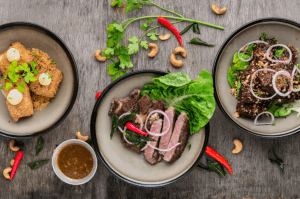Contributor: Greg Bell
This summer’s The Fancy Food Show in New York was an impressive spectacle showcasing thousands of specialty foods manufacturers from across the country, sharing the latest and greatest condiments, confections, breads, beverages, mixes, lifestyle recipes, and so much more. But rising among all the new products was an air of generational growth – and demand through buying power. Z-Gens, X-Gens and Millennials are now driving the world; and as a Boomer myself, I had to learn that I can choose to sit and watch or keep running and adapt.
food-300×199.png First, let’s look at what makes a specialty food. Typically, specialty food companies are made up of start-up, small volume entrepreneurs looking to enter the retail markets through retailers big and small. They offer new innovations in many categories of food, the largest being confections, condiments and mixes; and they’re “life-styled,” meaning they’re designed with choices in mind such gluten-free products, no GMOs, and specific diet guidelines such as paleo, vegetarian or vegan. In short, they’re created with Z-gens, X-gens and Millennials in mind.
First, let’s look at what makes a specialty food. Typically, specialty food companies are made up of start-up, small volume entrepreneurs looking to enter the retail markets through retailers big and small. They offer new innovations in many categories of food, the largest being confections, condiments and mixes; and they’re “life-styled,” meaning they’re designed with choices in mind such gluten-free products, no GMOs, and specific diet guidelines such as paleo, vegetarian or vegan. In short, they’re created with Z-gens, X-gens and Millennials in mind.
Based on my own observations as a veteran of the food industry, the Z-Generation value nutritional and ingredient information and prioritize quality ingredients. They prefer to shop with companies whose values and philosophies mirror their own, and they like to support small businesses. Z-Gens tend to make meals from quick-start kits and jarred sauces and enjoy snacking rather than making full meals. Interestingly, they’re also most likely to purchase plant-based meat alternatives.
Millennials and Gen X-ers are similar to Z-Gens because they enjoy talking about good food, value nutritional and ingredient information, prioritize clean ingredients, and love to treat themselves. Are you familiar with Blue Apron, the meal kit delivery service? Millennials are their core customer group (Millennials also purchase ready-to-eat meals at stores.) On the other end of the spectrum, Gen X-ers prefer to cook from scratch – but they’re the second most likely consumers after Millennials to purchase ready-to-eat foods or meal kits.
As a Baby Boomer, I’ve noticed my generation enjoys locally or regionally-sourced quality ingredients. We also enjoy interesting tastes and flavors for every day meals, and we cook from scratch. But that doesn’t mean we can’t expand our food focus beyond what we’re used to and learn from the generations coming up behind us.
While a lot of foods were geared to Z-Gen, X-Gen and Millennials, some really stood out from the crowd – and became my favorite new foods. One such treat was a cauliflower pizza crust, which was crispy and had outstanding flavor. I also enjoyed Sober Dough, a breadmaking kit that included a can of beer and a mix that baked wonderful breads in a snap. Then there was SAP, a Birch sap-based sparkling water, which had a terrific taste and finish. And then there were Puffworks Peanut Butter Puffs, a healthier alternative for those who love cheese puffs.
 Meanwhile, the convention’s international section also had some unique offerings for these generations, and a vast selection from around the world. There was a tremendous display of the largest selection of olives and cheeses from everywhere, along with a wide selection of oils that included nut oils, seed oils, and palm oils that can be used for nearly everything. Roma Tomatoes gave out samples of vegan sushi, which looked and tasted like salmon sushi – and it even had the same texture. Another innovative company, FABA, made a vegetable butter substitute made from chickpeas that I can’t believe is not butter.
Meanwhile, the convention’s international section also had some unique offerings for these generations, and a vast selection from around the world. There was a tremendous display of the largest selection of olives and cheeses from everywhere, along with a wide selection of oils that included nut oils, seed oils, and palm oils that can be used for nearly everything. Roma Tomatoes gave out samples of vegan sushi, which looked and tasted like salmon sushi – and it even had the same texture. Another innovative company, FABA, made a vegetable butter substitute made from chickpeas that I can’t believe is not butter.
I can’t wait to see all these products in markets and see how they resonate with the next generations of foodies. As for this foodie, I’m ready to keep running, adapting, and seeing what comes next from the innovative world of specialty foods.




